Garmin Instinct 3 vs. 2X vs. 2: Every key upgrade
The Garmin Instinct 3 vs. 2 has major differences in battery life, accuracy, smarts, display quality, and memory, but the Instinct 2X is surprisingly similar.
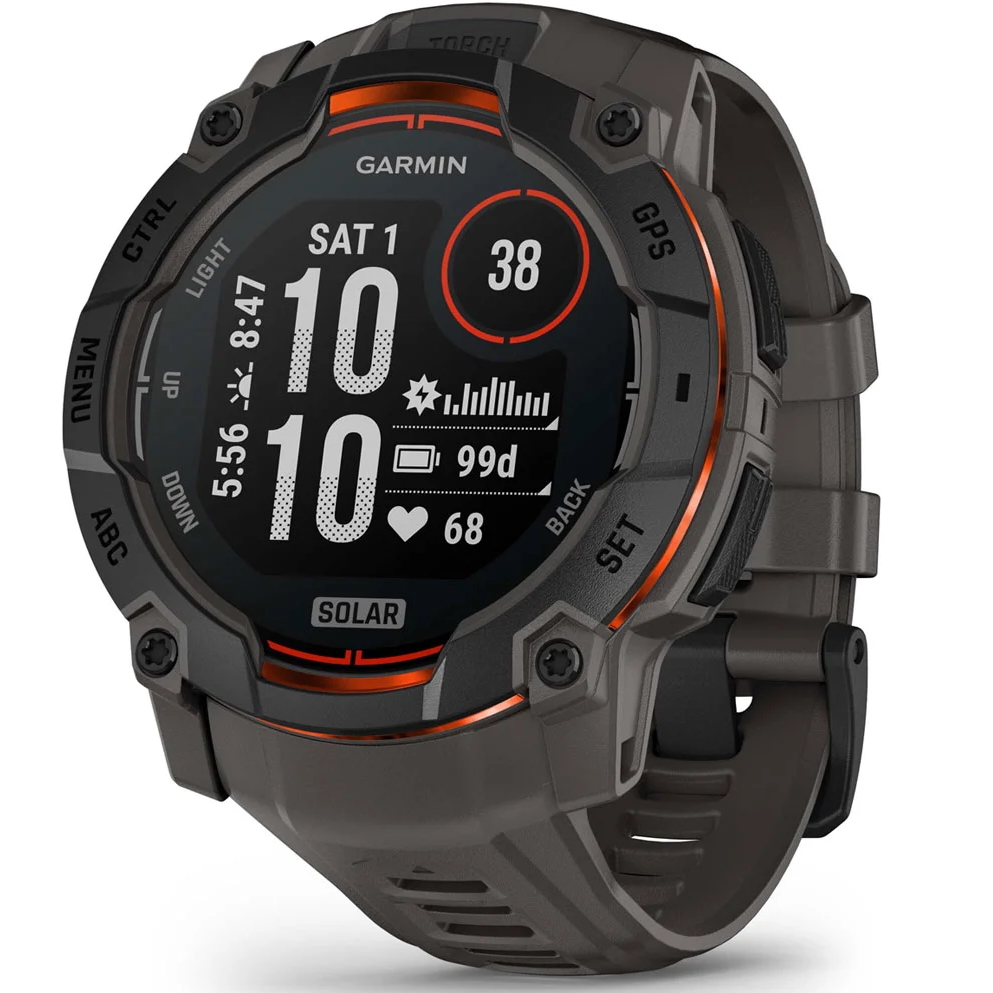
Pick AMOLED or Solar
The Garmin Instinct 3 offers a significant step up over the Instinct 2, but less so for Instinct 2X owners who already have a flashlight, improved solar recharge, and multi-band GPS. The Solar version has absurdly good battery life but the same visual downsides the Instinct series has had for years; the AMOLED version dips to a respectable 18–24 days but has a few extra features to go with the color and resolution.
For
- Instinct 3 Solar beats 2 Solar by over 200 GPS hours
- Instinct 3 AMOLED only model with full-color, high-res display
- Adds highly accurate multi-band GPS, flashlight
- New training tools, sleep coaching, and dozens of sports modes
- Stylish aluminum bezel
Against
- No upgrade to health sensors (aka no ECG, skin temp)
- Instinct 2X Solar already had some of the new upgrades
- No offline maps or new software unique to Instinct lineup

Last-gen quality
The Garmin Instinct 2 blew us away in 2022, and it's still a data-packed, long-lasting watch with all the Garmin software essentials in 2025. But its solar recharging efficiency isn't on the same level as the Instinct 3 or 2X, and you may resent the lack of a more accurate GPS mode and the low-contrast, low-res display. The Garmin Instinct 2X falls between the two, being the first to introduce the flashlight, and the main 2X-to-3 gap is for battery life.
For
- Both Instinct 2 and 2X have more than enough battery life for most people
- Same military-grade ruggedness
- Same display resolution, health sensors and 90% of same training tools
Against
- Solar recharge on older models isn't nearly as efficient
- Minimal memory restricts future feature updates
- No AMOLED option
- No flashlight, gyroscope
- Only offers GPS tracking on 2, no SatIQ on 2X
Comparing the Garmin Instinct 3 vs. 2 is more complicated than you'd think. The Garmin Instinct 3 has both AMOLED and MIP Solar versions in multiple sizes, each with a different battery life. The Garmin Instinct 2 and smaller 2S each have solar and non-solar options, and there's an Instinct 2X that falls in the middle between these two generations.
All three watches are almost unparalleled for battery life — not counting the expensive Garmin Fenix 8 or Enduro 3. The Instinct 3 Solar gives you a 5X boost in solar efficiency over the Instinct 2 Solar, but the gap is smaller for Instinct 2X Solar owners. And even though the Instinct 3 AMOLED has no solar recharge, it may last longer or shorter than the Instinct 2 Solar depending on your lifestyle.
Now you're starting to see why this guide isn't so straightforward! But we'll break down every key difference in hardware, design, software features, and battery life across each version and generation, to help you decide whether to upgrade, stick with your current watch, or buy a last-gen model on sale for a low price.
Our previous guides on the Instinct vs. Instinct 2 guide or Instinct 2 Solar vs. 2X Solar break down last-gen differences for background information. This Instinct 3 vs. Instinct 2X vs. Instinct 2 guide will focus on whether the latest generation is upgraded enough to earn your money!
A brief Garmin Instinct 3 AMOLED vs. Solar breakdown
Before I compare the Instinct 3 vs. Instinct 2, I want to highlight key differences between the four Instinct 3 watches.
Category | Instinct 3 AMOLED 50mm / 45mm | Instinct 3 Solar 50mm / 45mm |
|---|---|---|
Size | 50 x 50 x 14.4 mm; 45 x 45 x 14.9 mm | 50 x 50 x 14.4 mm; 45 x 45 x 14.9 mm |
Weight | 59g / 53g | 58g / 52g |
Display | 1.3-inch (416x416) or 1.2-inch (390x390) full-color AMOLED non-touch | 1.1-inch (176x176) or 0.9-inch (176x176) two-window memory-in-pixel non-touch |
Memory | 4GB | 128GB |
Battery life | 50mm: 24 days (9 AOD), 40 GPS hours, 30 hours multi-band GPS, 86 hours Max Battery GPS, 20 days Expedition GPS; 45mm: 18 days (7 AOD), 32 GPS hours, 23 multi-band GPS hours, 68 hours Max Battery GPS, 16 days Expedition GPS | 50mm: 40 days/ Unlimited with solar, 60 GPS hours / 260 with solar, 34 multi-band GPS hours / 60 with solar, 150 hours Max Battery GPS / Unlimited with solar, 60 days Expedition GPS / Unlimited with solar; 45mm: 28 days / Unlimited with solar, 40 GPS hours / 130 with solar, 24 multi-band GPS hours / 40 with solar, 100 hours Max Battery GPS / Unlimited with Solar, 36 days Expedition GPS / Unlimited with Solar |
As you can see, the two 45mm models are slightly lighter and thicker than their 50mm counterparts. Both AMOLED watches have the same pixels per inch, while the smaller Instinct 3 Solar has a petite screen with a higher PPI than the 50mm Solar. The larger and smaller watches use 26mm and 22mm bands, respectively, but they should all fit the same wrist sizes.
Either MIP display is much lower-resolution and monocolored, while the AMOLED watches provide a real visual upgrade. They also add perks like on-screen workout animations, always-on display, or images from notifications that the MIP watches can't offer. But neither AMOLED nor MIP Solar has a touchscreen.
Be an expert in 5 minutes
Get the latest news from Android Central, your trusted companion in the world of Android
In exchange for a worse visual experience, the Garmin Instinct 3 Solar has fantastic battery recharging capable of stretching standard GPS tracking to last for weeks at a time — longer than the Instinct 3 AMOLED might last with no GPS tracking. Both 45mm Instinct 3 watches have a noticeable dip in battery life compared to their 50mm counterparts; you can see the differences above.
For the following sections, I'll only include the 50mm Instinct 3 AMOLED and Solar when comparing against the last-gen watches, to make the comparison less cluttered and easier to parse.
Garmin Instinct 3 vs. 2X vs. 2: Battery life
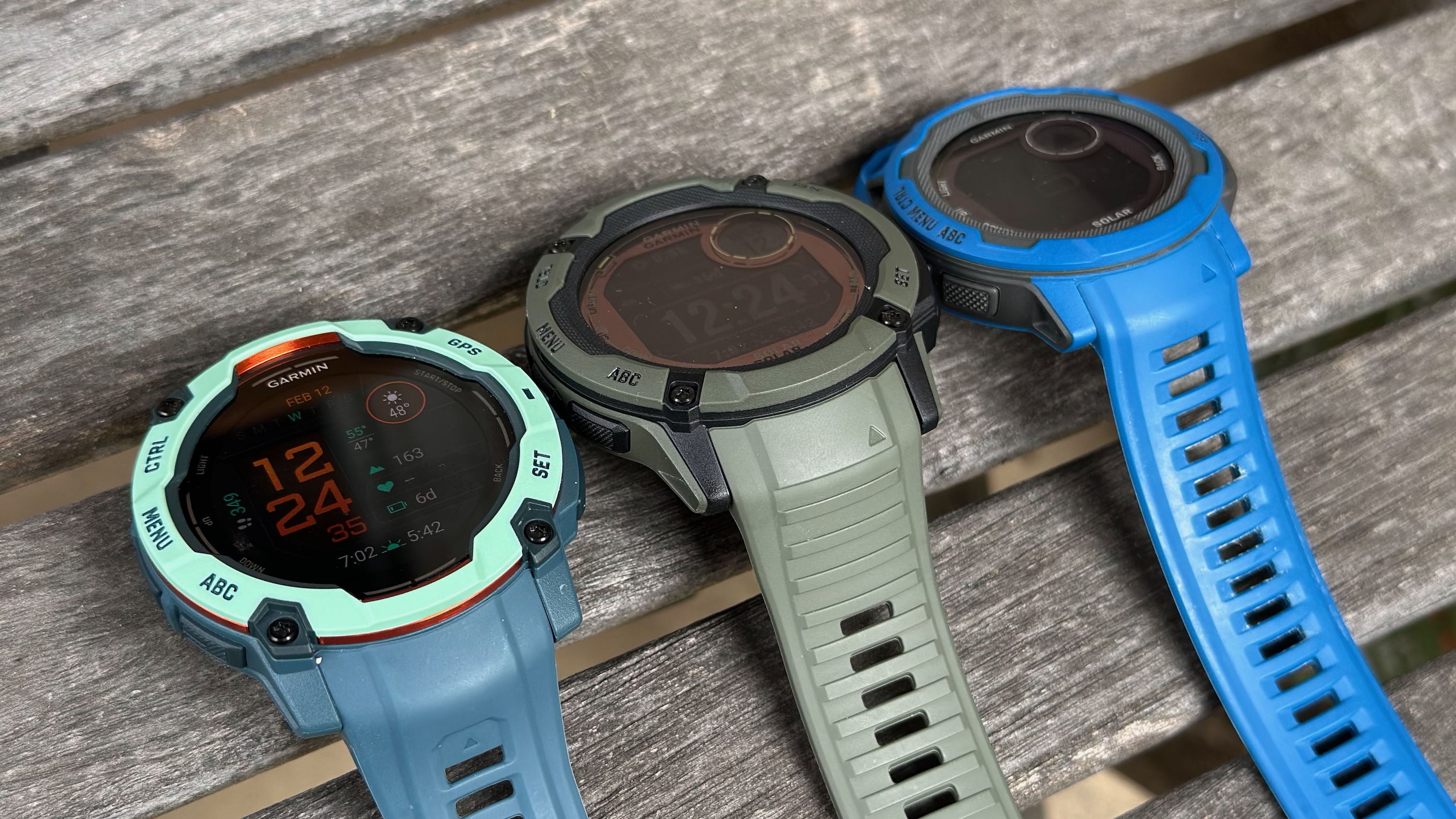
Battery category | Garmin Instinct 3 50mm AMOLED | Garmin Instinct 3 50mm Solar | Garmin Instinct 2X Solar | Garmin Instinct 2 Solar |
|---|---|---|---|---|
Smartwatch mode | 24 days | 40 days; Unlimited w/ solar | 40 days; Unlimited w/ solar | 28 days; Unlimited w/ solar |
GPS only | 40 hours | 60 hours; 260 hours w/ solar | 60 hours; 145 hours w/ solar | 30 hours; 48 hours w/ solar |
All satellite systems + multi-band | 30 hours | 40 hours; 80 hours w/ solar | 27 hours; 36 hours w/ solar | N/A |
Max Battery GPS | 86 hours | 150 hours; Unlimited w/ solar | 150 hours; Unlimited w/ solar | 70 hours; 370 w/ solar |
Expedition GPS | 20 days | 60 days; Unlimited w/ solar | 60 days; Unlimited w/ solar | 25 days; 105 days w/ solar |
Let's start with the Garmin Instinct series' trademark perk: Epic battery life. While the Garmin Instinct 2 Solar offered "unlimited" battery life, that was only in the context of never using GPS, using Max Battery mode (one GPS check per minute), or using Expedition mode (one GPS check per hour with no sensors or accessories). The efficiency of the solar panel wasn't especially strong.
You can see how the Garmin Instinct 3 Solar panel adds 200 estimated GPS hours of tracking, based on whether or not you're spending at least three hours a day in sunny conditions. Compared to that, the Instinct 2X Solar's 85 extra hours are respectable but well short; the Instinct 2 Solar's 18 hours felt significant back in 2022 but barely feels like a blip now.
Where the Instinct 3 Solar especially shines is for multi-band GPS tracking. Because that mode is so power-hungry, the Instinct 2X Solar could only add a few extra hours before it died. The newest model can still double your efficiency while offering the best location data that Garmin has to offer.
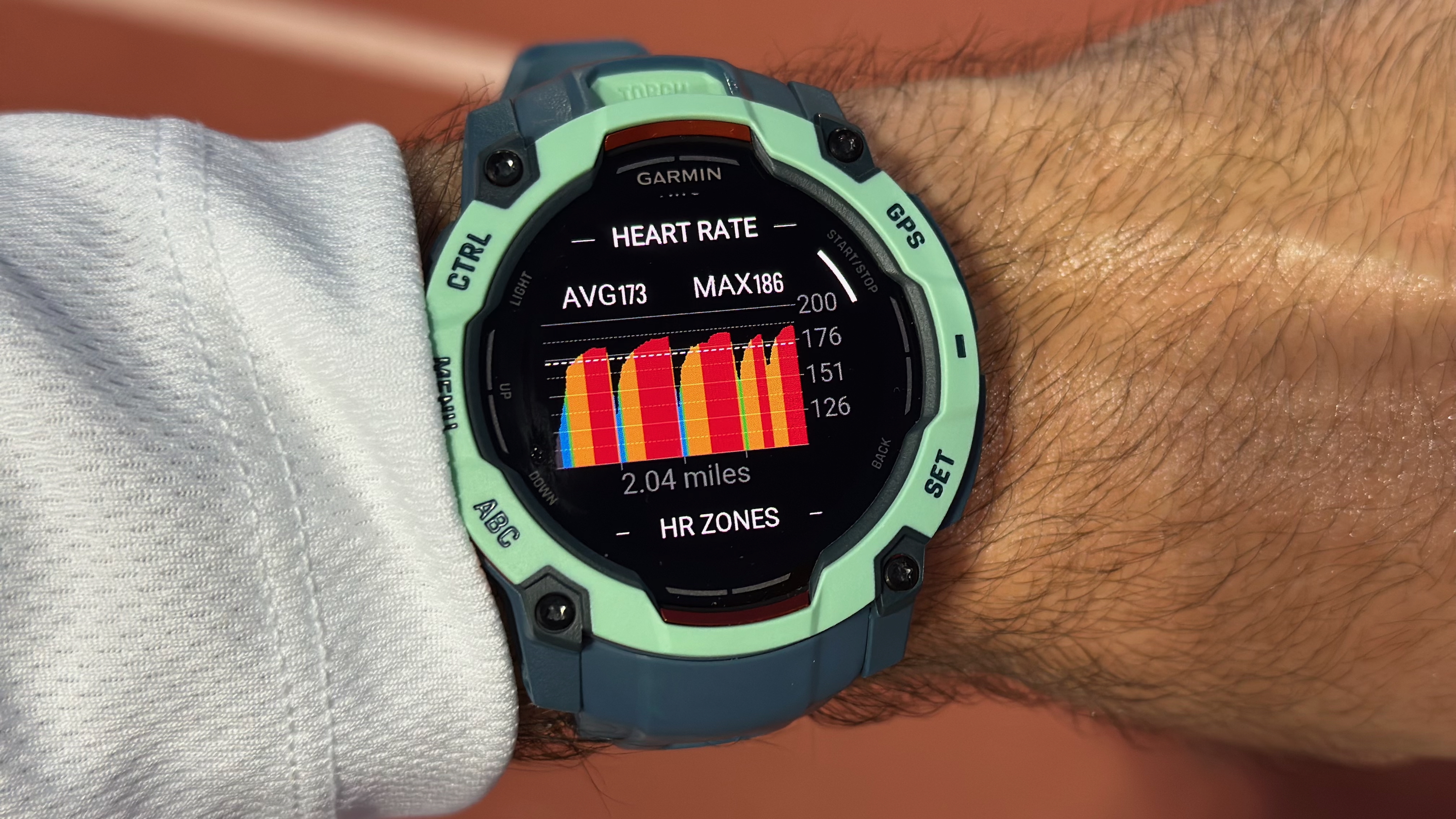
The Garmin Instinct 3 AMOLED barely belongs in the same conversation as these MIP watches, but it's not as deficient as you might think. Its 40 GPS hours beat the Instinct 2 Solar's 30-hour estimate, only losing if you spend enough time outdoors in ideal conditions to get the recharge. You can enjoy a much better display and GPS accuracy without having to worry about the weather or hiking in the shade.
Should you upgrade for better battery life? Garmin Instinct 2X Solar buyers probably shouldn't unless they find a trade-in deal and really need an extra 100+ hours of GPS battery; you're already getting "unlimited" Max Battery or Expedition mode, so an Instinct 3 upgrade only applies if you need literal days of per-second GPS tracking and don't have any means of charging your Instinct 2X Solar overnight.
But if you have an older Instinct 1 or 2, your new battery boost will be at a whole other level — or else you can choose the Instinct 3 AMOLED and still get comparable or better battery life.
Garmin Instinct 3 vs. 2X vs. 2: Design and display
Category | Garmin Instinct 3 50mm AMOLED | Garmin Instinct 3 50mm Solar | Garmin Instinct 2X Solar | Garmin Instinct 2 Solar |
|---|---|---|---|---|
Materials | Polymer case; aluminum bezel; silicone strap | Polymer case; aluminum bezel; silicone strap | Polymer case; silicone strap | Polymer case; silicone strap |
Protection | Chemically strengthened glass; 10ATM; MIL-STD-810 | Power glass; 10ATM; MIL-STD-810 | Power glass; 10ATM; MIL-STD-810 | Power glass; 10ATM; MIL-STD-810 |
Size | 50 x 50 x 14.4 mm, 59g | 50 x 50 x 14.4 mm, 58g | 50 x 50 x 14.5 mm, 67g | 45 x 45 x 14.5 mm, 53g |
Display | 1.3-inch (416x416) AMOLED | 1.1-inch (176x176) MIP | 1.1-inch (176x176) MIP | 0.9-inch (176x176) MIP |
Sensors | Elevate v4 HR, SpO2, accelerometer, altimeter, compass, gyroscope | Elevate v4 HR, SpO2, accelerometer, altimeter, compass, gyroscope | Elevate v4 HR, SpO2, accelerometer, altimeter, compass | Elevate v4 HR, SpO2, accelerometer, altimeter, compass |
Tracking | GPS, GLONASS, GALILEO, SatIQ, multi-band GPS | GPS, GLONASS, GALILEO, SatIQ, multi-band GPS | GPS, GLONASS, GALILEO, multi-band GPS | GPS, GLONASS, GALILEO |
Connectivity | Bluetooth, ANT+, NFC | Bluetooth, ANT+, NFC | Bluetooth, ANT+, NFC | Bluetooth, ANT+, NFC |
LED flashlight |
The changes across the Garmin Instinct series for this latest generation are fairly subtle. The Instinct 2X Solar is slightly heavier, but otherwise they're about the same size and weight, have the same military-grade durability against thermal, shock, and water damage, connect to the same accessories, and measure the same health data like heart rate, HRV, and blood oxygen.
While everyday people might find the Instinct series ugly — the 2X Solar scored last place in my smartwatch beauty pageant — fans of sporty watches will appreciate its classic look. Garmin gave the Instinct 3 a bit more personality with an aluminum bezel around the display edge that looks striking, especially on the limited-edition models that add color contrast to the bulky, monocolor silicone.
Garmin has given the memory-in-pixel Solar Instincts the same 176 x 176 resolution over the last couple of generations. That said, Garmin upped the visual contrast on the Instinct 2X compared to the Instinct 2, making it more readable, and while I haven't tested the Instinct 3 Solar myself, I've heard that this version is even more readable despite having the same pixels.
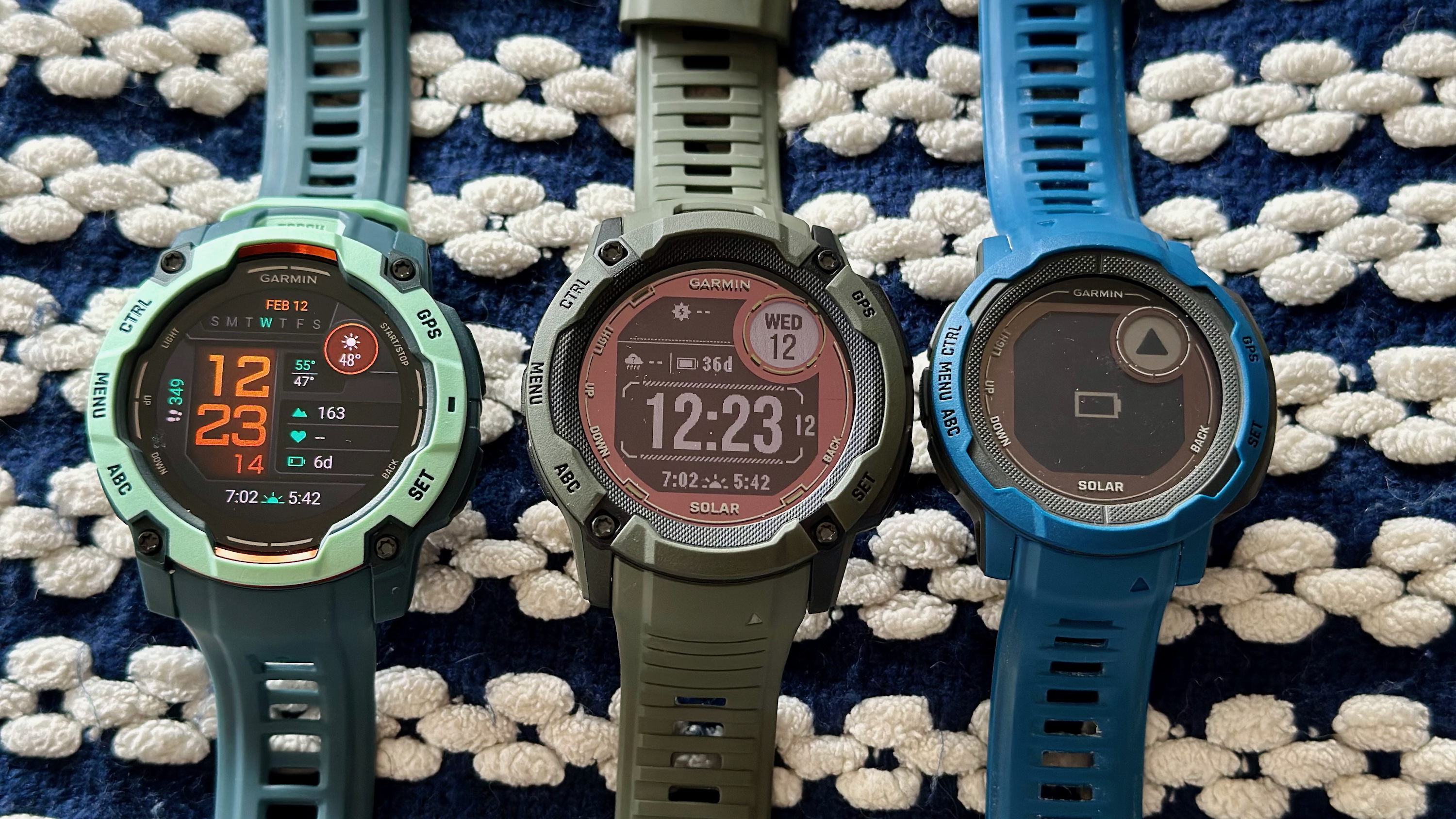
All non-AMOLED Garmin Instincts have a second window that takes up visual real estate. Some Instinct 3 Solar buyers have complained about the data being misaligned within the circular space, but it's hard to say how common these manufacturer defects are. The biggest issue is that this window — and the low resolution overall — prevent any possible maps, images, or full-screen graphs. Newer models are more readable, but none are fun to look at outside of workouts!
The Garmin Instinct 3 AMOLED has the same size and resolution as the Garmin Forerunner 265, though slightly smaller than the 1.4-inch Venu 3. What's more relevant is that this display is non-touch, so you'll still have to rely fully on the Up/ Down buttons to navigate, and there is no map navigation. Still, you can trust me when I say that this upgrade makes the Instinct 3 much easier to read indoors and enables colorful graphs that look dull and blurry on the Instinct 2 or 2X.
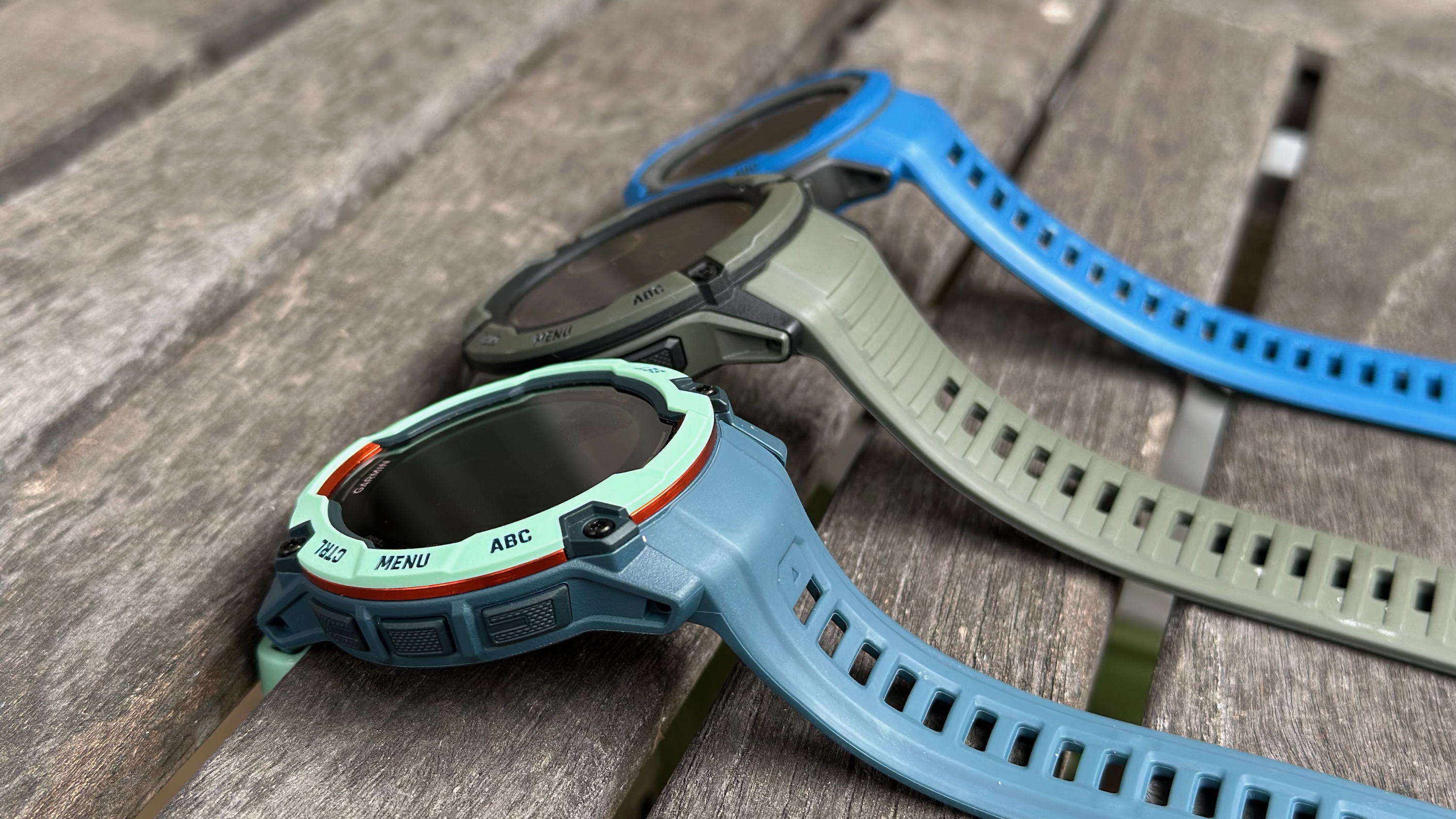
The Garmin Instinct 2X added multi-band GPS over the GPS-only Instinct 2, matching the Instinct 3 for accuracy. The only difference is that the newer watch has SatIQ mode, which defaults to GPS alone unless the watch encounters signal interference and needs other GNSS or the L5 GPS frequency to pinpoint you. This saves hours of battery life but ensures better accuracy in tough conditions.
This mid-generation watch was also the first Instinct to add a built-in LED flashlight; the brightness is the same on the 2X and 3. It's good enough in a pinch but won't replace an actual flashlight or headlamp for night conditions. It burns through a healthy amount of battery, too, so the Instinct 3's more efficient solar panel might come in handy if you use it a lot.
Garmin Instinct 3 vs. 2X vs. 2: Software
Category | Garmin Instinct 3 | Garmin Instinct 2X | Garmin Instinct 2 |
|---|---|---|---|
Memory | 4GB (AMOLED); 128MB (MIP) | 64MB | 32MB |
Sleep & health | Sleep score, sleep coach, nap detection, resting heart rate, breathing rate, Body Battery, all-day stress, HRV status, blood oxygen, health snapshot | Sleep score, resting heart rate, breathing rate, Body Battery, all-day stress, HRV status, blood oxygen, health snapshot | Sleep score, resting heart rate, breathing rate, Body Battery, all-day stress, HRV status, blood oxygen, health snapshot |
Smarts | Morning report, weather app, calendar, music playback (no storage), Find My Phone/ Watch, Garmin Messenger app, notification images (AMOLED/ Android only), incident detection, livetrack, live event sharing | Morning report, weather app, calendar, music playback (no storage), Find My Phone/ Watch, incident detection, livetrack | Morning report, weather app, calendar, music playback (no storage), Find My Phone/ Watch, incident detection, livetrack |
Key fitness data | Steps, floors, calories, intensity minutes, VO2 Max, auto max HR, daily suggested workouts, training readiness, training status, training effect, training load, training load focus / ratio, running dynamics, advanced cycling dynamics, running power, grade-adjusted pace, performance condition, race glance, improved intervals, | Steps, floors, calories, intensity minutes, VO2 Max, auto max HR, daily suggested workouts, training readiness, training status, training effect, training load, running power, grade-adjusted pace, performance condition | Steps, floors, calories, intensity minutes, VO2 Max, auto max HR, daily suggested workouts, training readiness, training status, training effect, training load, running power, performance condition |
The Garmin Instinct 2 shipped with most of the best Garmin Forerunner training tools available at the time, providing enough health and training load to help you become fitter and improve your VO2 Max. The gap between the Garmin Instinct 3 and 2 software isn't especially wide, but the new watches have more memory, leaving room for new feature updates that the Instinct 2 series will miss out on — and also eliminating some of the noticeable lag on the last-gen watches.
For now, the table above bolds those features that the Instinct 3 has that the 2X and 2 don't.
For health data, the Instinct 3 can detect naps for enhanced Body Battery data and will provide sleep coaching in your Morning Report. Otherwise, the data is identical, since they all use the same Elevate v4 sensors.
For general smarts, the Instinct 3 Solar isn't that different, but the AMOLED version will display notification images and (during Garmin Strength Coaching) display visual muscle maps and workout animations. It also has a large font option that the MIP watches lack. Only the Instinct 3 allows family and friends to watch you during a live event, but all the watches have a general LiveTrack tool if you want them to keep an eye on your progress during outdoor excursions.
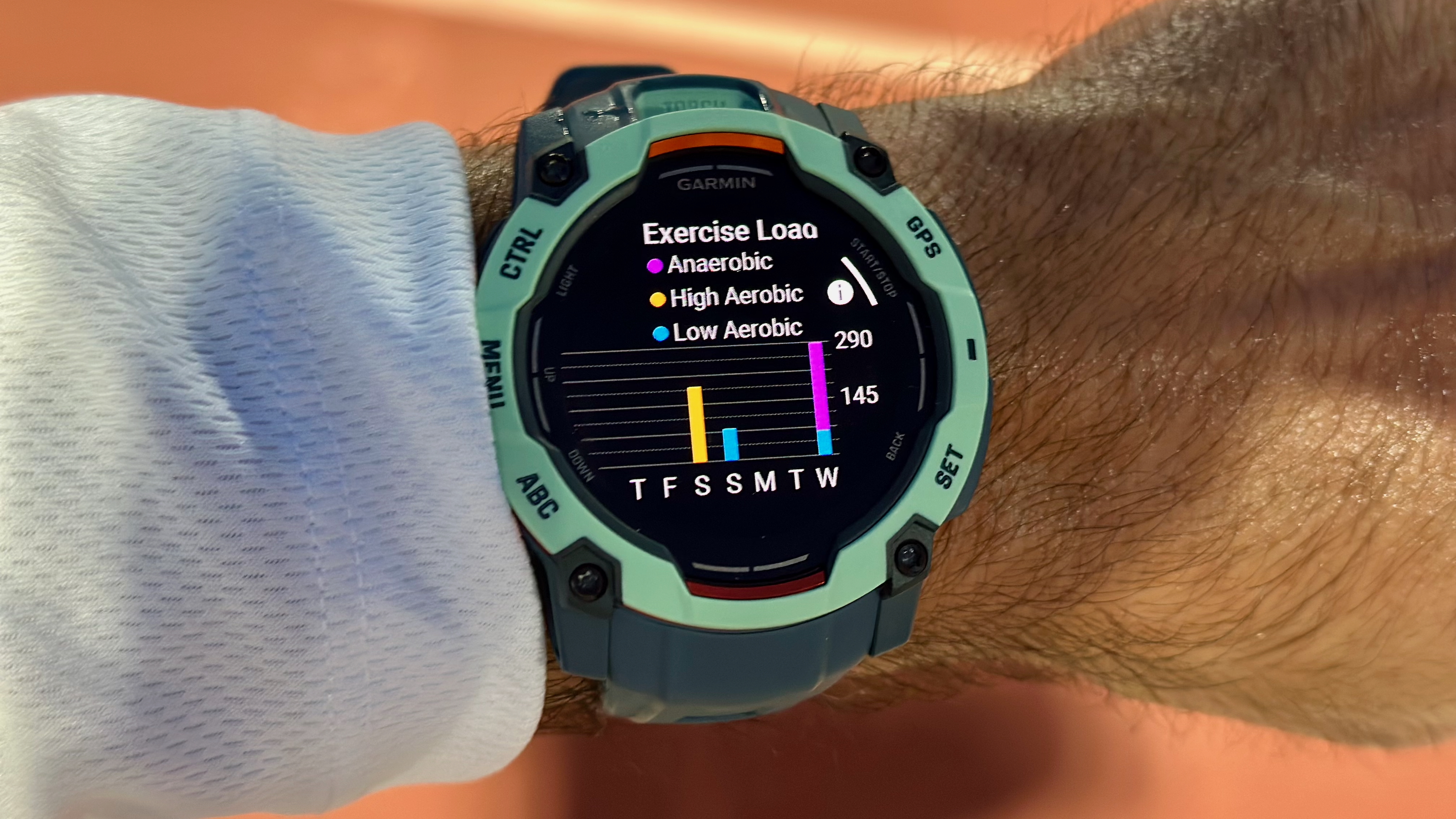
On the training front, serious athletes will appreciate having training load focus, which splits up your recent workouts into low/ high aerobic and anaerobic types so you know what types you need to focus on to improve, as well as your training load ratio comparing this week to past weeks.
If you want to do interval training, only the Instinct 3 shows a rest timer and has improved tools like auto-detected starts and open repeats. The same goes for auto-detecting when your multisport activity has switched to the next type, or for following PacePro guidance.
If you're a runner or cyclist who wants to analyze your form, the Instinct 3 has wrist-based running dynamics — the Instinct 2 and 2X required a separate pod — and cycling dynamics like Power Phase and right/left balance.
Lastly, Instinct 2 owners will get dozens of new sports modes on the Instinct 3 series: Indoor walking, virtual running, obstacle racing, golfing, disc golf, archery, cyclocross, BMX, water skiing, snorkeling, wakeboarding, wakesurfing, tubing, boating, whitewater, XC skate skiing, ice skating, pickleball, badminton, squash, table tennis, padel, platform tennis, racquetball, basketball, volleyball, field hockey, ice hockey, football/soccer, American football, lacrosse, rugby, ultimate disc, cricket, softball, baseball, boxing, mixed martial arts, motorcycling, overlanding, motocrossing, ATVing, and snowmobiling.
It's fair to say that most of these sports profiles won't apply to your lifestyle, but anyone with niche hobbies will find the Instinct 3 more helpful at tracking them.
Garmin Instinct 3 vs. 2X vs. 2: Should you upgrade?
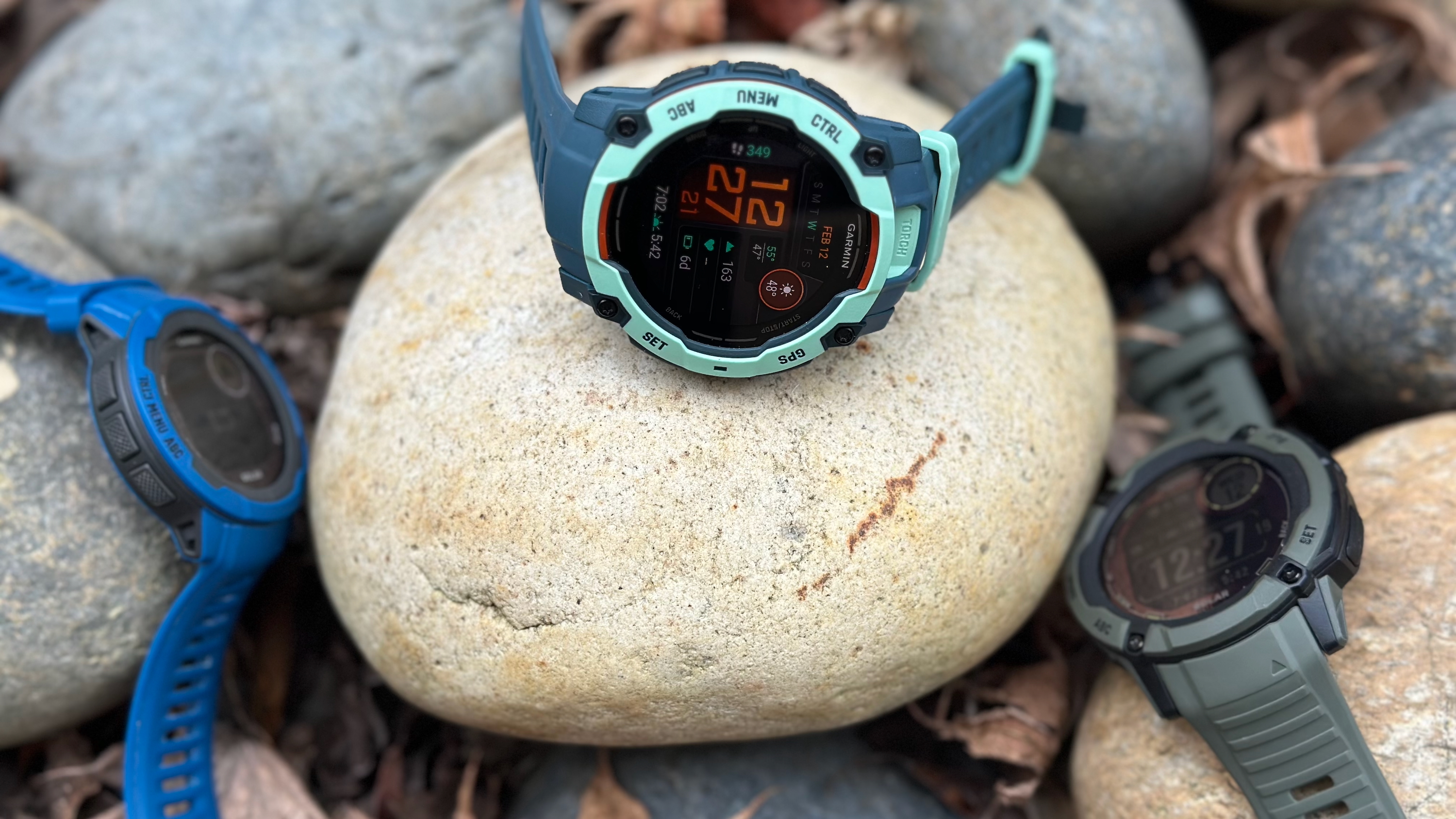
The Garmin Instinct 3 is an undeniable step up on every other Instinct before it. If you're deciding between a full-priced Instinct 3 or a discounted Instinct 2, I think perks like the revamped solar charging or AMOLED, multi-band GPS, flashlight, and aluminum bezel make it worth spending full price.
But as I've previously written, you can criticize the Instinct 3 Solar for how similar it is to the Instinct 2X aside from the boosted battery life. If you own the Garmin Instinct 2X, I would hold off on buying the Instinct 3, simply because you just spent $450 and you'll get diminished returns.
The Instinct 3 AMOLED is my preferred choice from a visual perspective, it doesn't have a trademark skill like the Solar watches' unlimited battery life. It's just a rugged, bulky Forerunner 265. If you can accept the lack of a flashy new perk, this is undoubtedly one of the best Garmin watches available.
If you've owned an Instinct 1 or 2 for a couple of years, it's not a bad time to upgrade. Just make sure that you really need that extra Solar battery life, or that you can do without "unlimited" max-battery excursions for a better display.

Two options, both strong
Upgrade to the Garmin Instinct 3 Solar if you're not satisfied with your current Instinct Solar battery life. Or upgrade to the Instinct 3 AMOLED if you like the series' durability and aesthetics but want to prevent eye strain and add a little pop of color. Skip this watch if you already have the Instinct 2X Solar.

Last-gen champion
You can buy the Instinct 2 if you find it at a significant discount, but certain aspects like the GPS-only tracking, limited memory, and low-contrast display will age poorly. If you can accept that, we gave this watch a strong review for a reason; if you can't, consider grabbing the Instinct 3 Solar instead.

Michael is Android Central's resident expert on wearables and fitness. Before joining Android Central, he freelanced for years at Techradar, Wareable, Windows Central, and Digital Trends. Channeling his love of running, he established himself as an expert on fitness watches, testing and reviewing models from Garmin, Fitbit, Samsung, Apple, COROS, Polar, Amazfit, Suunto, and more.
You must confirm your public display name before commenting
Please logout and then login again, you will then be prompted to enter your display name.
